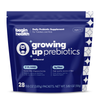What are Osmotic Laxatives?
share this article

Osmotic laxatives are commonly used medications to relieve constipation by drawing water into the bowel, softening stool, and promoting bowel movements. In this blog, we’ll review the mechanics of osmotic laxatives and explore different categories this laxative category, along with examples.
How Do Osmotic Laxatives work?
Osmotic laxatives work by drawing water into the colon, which softens stool and promotes bowel movements. They are commonly used to alleviate constipation and are available in various forms, including oral solutions, powders, and tablets.
Daily reads to help your little ones lead happier and healthier lives.
Join the
Happy Gut Club
Examples of Osmotic Laxatives
Polyethylene glycol (PEG): PEG is a commonly prescribed osmotic laxative available in powder form. It is tasteless, odorless, and typically mixed with water or other fluids before consumption. PEG works by increasing the water content in the colon, softening stool, and facilitating bowel movements.
Lactulose: Lactulose is a synthetic sugar solution that acts as an osmotic laxative by drawing water into the colon and promoting the growth of beneficial bacteria. It is often prescribed to treat chronic constipation and hepatic encephalopathy.
Magnesium hydroxide: Magnesium hydroxide, also known as milk of magnesia, is an osmotic laxative that works by attracting water into the intestines, leading to increased bowel movements. It is commonly used to relieve occasional constipation and is available in liquid and tablet forms.
Comparison Chart of Osmotic Laxatives
|
Osmotic Laxative |
Mechanism of Action |
Formulations |
Common Uses |
|
Polyethylene Glycol |
Draws water into the colon |
Powder |
Relieving constipation, bowel preparation |
|
Lactulose |
Attracts water, promotes bacterial growth |
Liquid |
Chronic constipation, hepatic encephalopathy |
|
Magnesium Hydroxide |
Attracts water into intestines |
Liquid, tablets |
Occasional constipation relief |
Summary
Osmotic laxatives, such as polyethylene glycol, lactulose, and magnesium hydroxide, work by drawing water into the colon to soften stool and promote bowel movements.
















